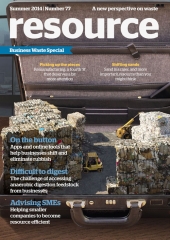Glass: a good sort
With various bodies indicating that glass is the hardest material to separate effectively at a MRF, Resource investigates whether it’s possible to obtain remelt-quality cullet from co-mingled collections
As local authorities look to comply with the separate collection requirement of the revised Waste Framework Directive, one material will cause the most concern for co-minglers: glass.
In his final move before his sudden departure from Defra, ex-Resources Minister Lord de Mauley sent a letter to councils explaining why: ‘[A]t present many of our existing MRFs [materials recovery facilities] struggle to keep glass shards out of the paper stream. In addition, many MRFs produce low-quality mixed glass, which needs further sorting and can be uneconomic to re-smelt.’
And, while government has since ‘stepped back’ on waste, others have likewise indicated that glass could be the sticking point for co-mingled collections. WRAP et al’s ‘Waste Regulations Route Map’, a ‘decision support tool’ (not legal advice) for councils looking to ensure compliance, echoes de Mauley’s sentiments. It states that councils wishing to co-mingle glass will need ‘very strong evidence’ to show they are ‘able to deliver high-quality recycling if [they] wish to argue that separate collection of glass is not necessary’.
WRAP’s good practice guide for glass collections, in fact, indicates that best practice is not only to
keep glass separate from other materials, but to separate by colour at the point of collection, as well, as this technique is ‘[m]ost likely to deliver the quality of cullet required by the glass remelt industry’, a route far preferable to sending low-quality glass to make aggregate. Co-mingling glass with other materials is considered a collection method of last resort, only to be used ‘[s]hould no other route be available’.
Some, however, say that glass can be just as easily sorted at a MRF as other materials – so long as the MRF has been designed in the right way. “I don’t necessarily think that it’s any harder than any of the other commodities”, Colin Richardson, Viridor’s Regional Manager for the South, says. “It’s just, historically, glass was not included in co-mingled collections, and I think it’s just a step change, and you’ve got to look at it in a different way.”
Indeed, Richardson concedes that early MRFs weren’t necessarily equipped to handle glass. Viridor was recently awarded a contract to upgrade a MRF for Plymouth City Council, in anticipation of which the council has added glass to its co-mingled recycling collections. Asked what changes will be made to the MRF to accommodate glass, he replies: “Everything… That is a first-generation [MRF], a very primitive sort. What we’re actually doing is upgrading and putting in a full, new MRF in there.” Richardson says the new facility will be “state of the art” and will be able to do a higher level of sort for all materials, including glass that will “predominantly” go on to the remelt market.
 This article was taken from Issue 77
This article was taken from Issue 77The key, he says, is knowing the quality required, as well as the volumes and particulate sizes of input material, before designing the MRF, and working backwards from there. Richardson explains: “You take the glass out as early as possible in any process, so hopefully at stage one just after production, you can drop the majority of your glass out through a trommel system to recover the majority of that from the other commodities.” At the new Plymouth MRF, the glass will drop through trommel screens onto its own conveyor system, “a mini MRF, if you like”, where “it will go through various processes – optical sorters and screens – until it gets to such a point that we’ve actually got the product that is actually suitable to go on to colour sort”.
Glass from MRFs, of course, will never be able to go directly for remelting, but clean, mixed cullet containing green, clear and amber glass can go on to a facility for further colour separation. The newly-released recycling quality specifications from the Resource Association indicate how much harder it is to obtain remelt-quality glass, though: reprocessors indicate that the limit for contamination in glass for remelt is between 0 and one per cent, whereas glass for aggregate can contain up to five per cent non-glass material. Newspapers and magazines, where glass contamination is of most concern, meanwhile, can only handle non-paper contamination of 0.5 per cent. It remains to be seen how many UK MRFs will actually be able to meet these challenging reprocessor requirements. 









